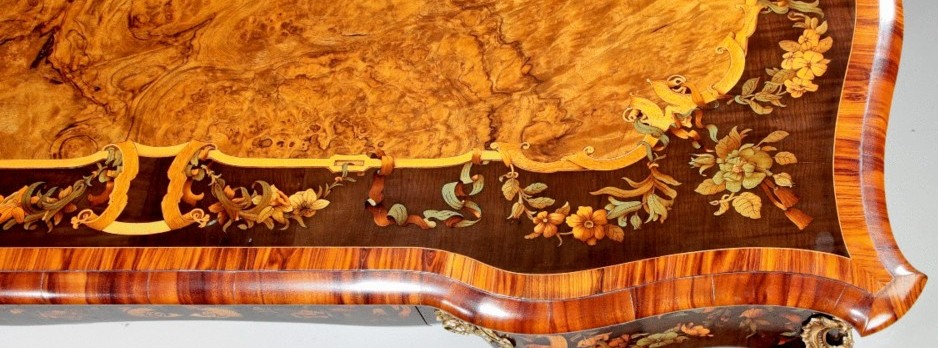Until the 18th century English furniture was generally made from trusty oak or very expensive oyster veneered walnut. Imagine, then, the excitement when cargoes of exotic timbers appeared from the tropics and other far-flung shores. One of the strengths of Lancaster furniture makers Gillows was their uncompromising demand for absolutely top quality timber – to the extent that they sourced and imported most of these woods themselves. In 1808 they made a box out of specimen woods for Miss Elizabeth Gifford of Nerquis Hall. The key lists 72 ‘rare and curious woods’. Coromandel, ebony, rosewood, tulipwood, satinwood, lacewood, zebra, partridge, kingwood, pear, purple heart, walnut, elm, yew, camphor, zitan, bamboo, cane, goncalo alves (tigerwood), huanghuali, sandalwood, apple, palm, teak, boxwood, calamander, cedar, jackwood, linden, lime, amboyna and bird-eye’s maple are some of the woods we still recognize and sell today.
In many cases the wood speaks for itself. Decoration relies on veneers which can be half, quarter, flame or book veneers where the timber has been sliced very thinly and the reciprocal patterns used to create dramatic designs: for example giving a waterfall effect across a piece of furniture, or a pattern radiating outwards. ‘Burr’ veneers are different, being achieved by cutting across the grain of the wood, preferably where knots or knurls have developed into interesting patterns.
However many of these imported timbers were expensive or rare and could not cover vast expanses of table top or cabinet front. Initially craftsmen incorporated samples or ‘specimens’ of every wood they could lay their hands on, and sometimes mother-of-pearl, bone or ivory for good measure. These pieces are often referred to as ‘specimen wood’ tables. When the design is purely geometric, this is known as ‘parquetry’. Later, the emphasis shifted away from simply showcasing such a wide range of woods towards designs of ever more intricate and complex patterns.
The partner to ‘parquetry’ is ‘marquetry’, which is any inlay where arabesques, flowers, vegetal forms, landscapes and figural subjects are portrayed. A traditional form of marquetry might comprise floral arrangements in harmonious colours, whilst elsewhere light and dark woods might be cleverly contrasted in a figural design. A further decorative technique was to stain light woods, usually boxwood, with dye, to make greens, blues and reds.
Arguably the most brilliant English exponents of the art of marquetry in the 19th century were Holland and Sons, cabinet makers to Queen Victoria, and Edward Holmes Baldock (1777-1845) – other makers of note include Edwards and Roberts, Lamb of Manchester, Seddon and Morel, Wright and Mansfield and the Blake family of cabinetmakers. The illustration across the top of the article is from an Edward Holmes Baldock library table. Here we have absolutely all the best decorative effects that wood can offer. The central field has a wonderfully fluid burr in the walnut, the marquetry has both exotic and stained woods to portray vivid ribbons and realistic flowers and there is a bright satinwood strapwork border on a stained harewood ground all within kingwood crossbanding. In the hands of a master craftsman like this – wood truly is wonderful.
By Caroline Wallrock at Wick Antiques
Browse for parquetry and marquetry:


